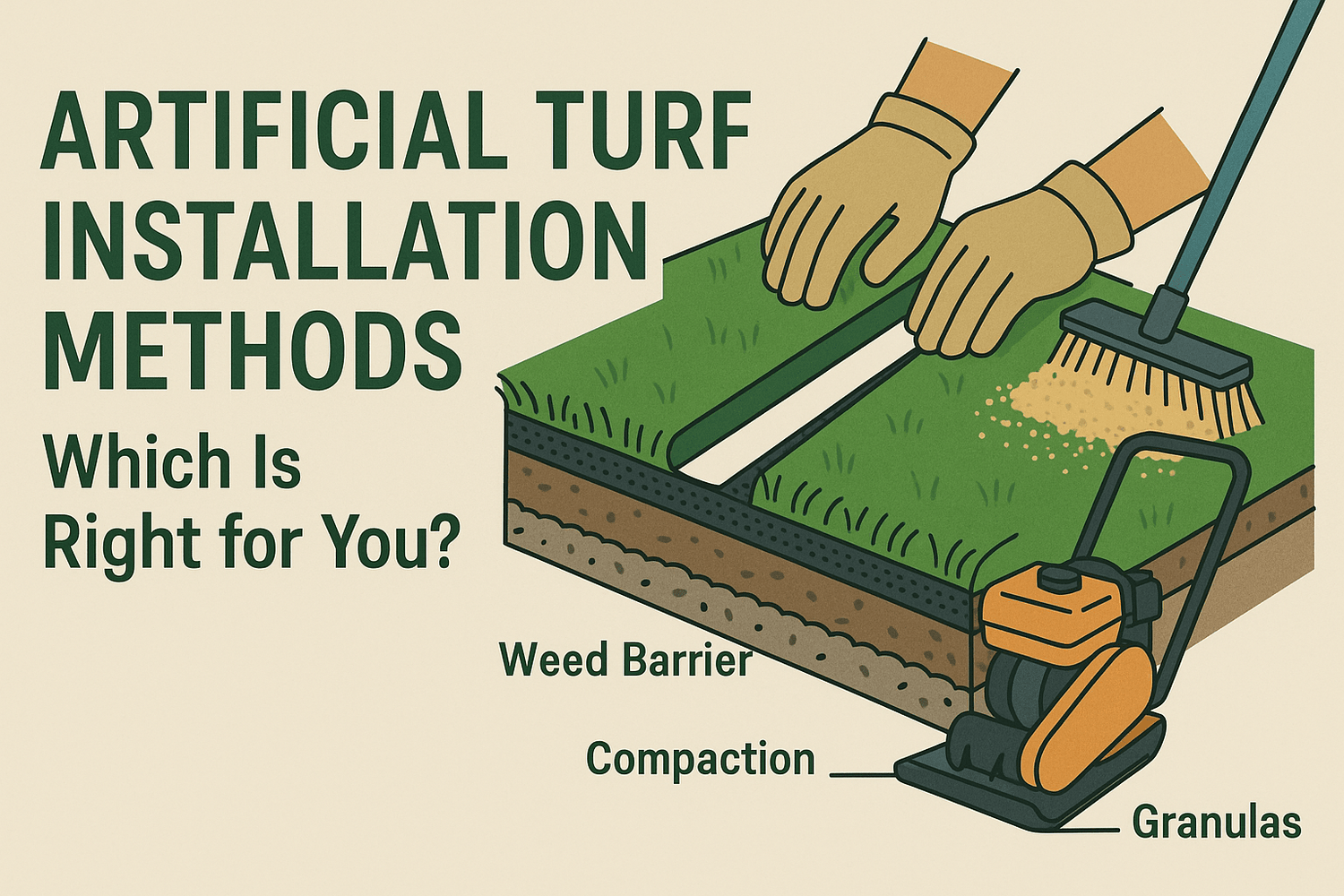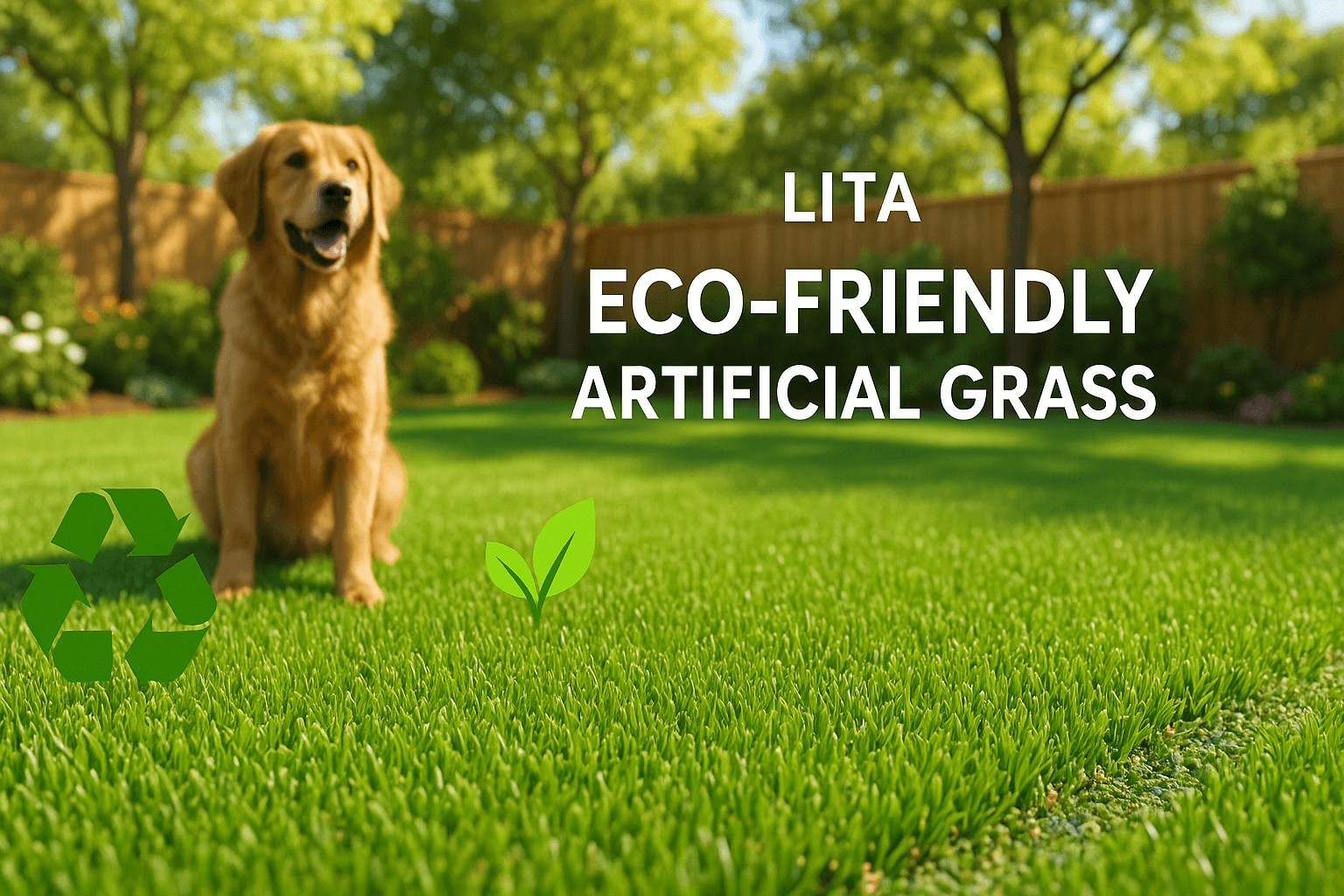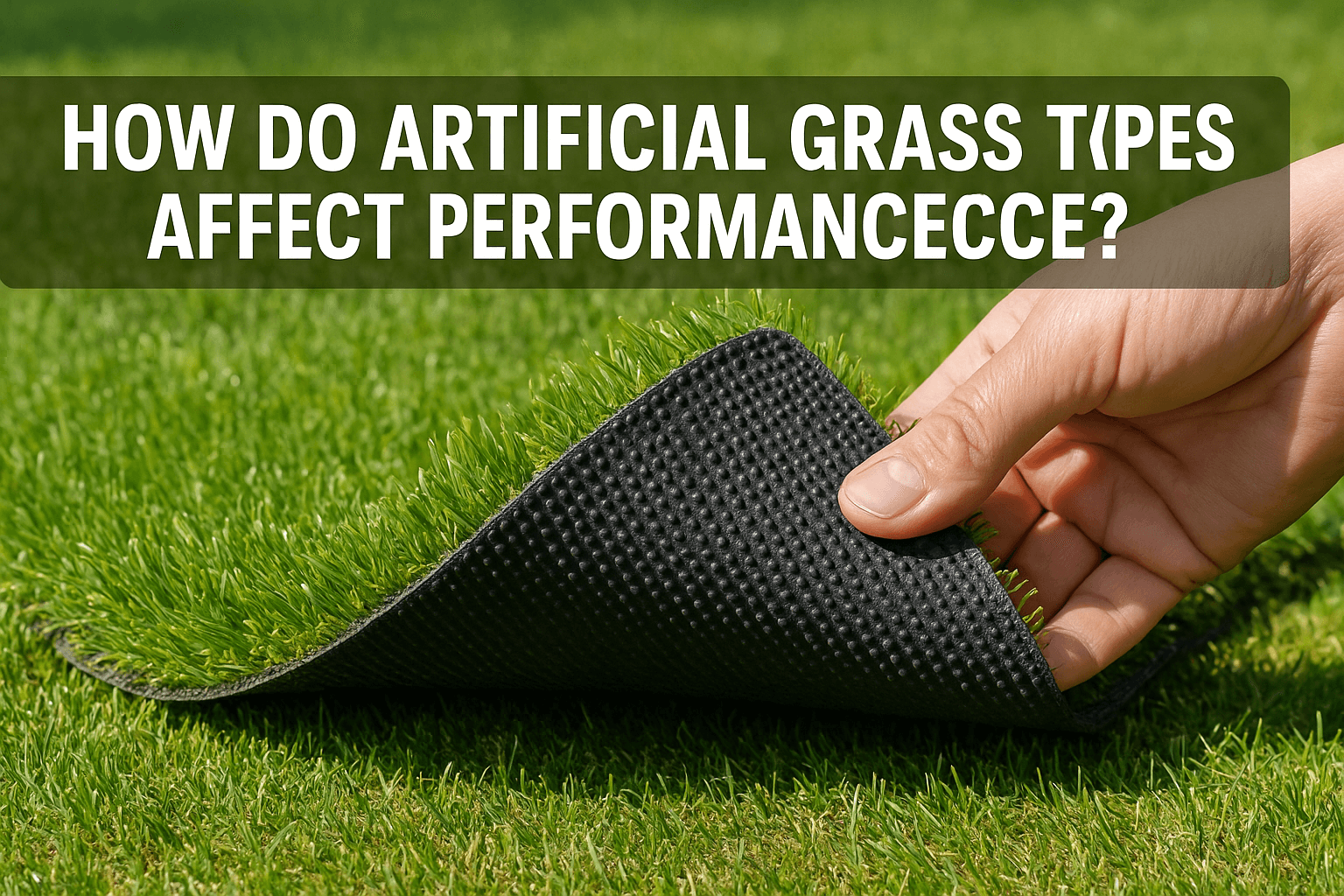Installing artificial turf can improve your yard, reduce maintenance, and save water. However, choosing the right installation method matters.
This guide explains the most common artificial turf installation methods, costs, timelines, and how to decide what works best for your space.
Whether you have a small patio, sloped yard, or want a putting green, you’ll find practical info here to help you plan smarter and avoid common mistakes.
Let’s start with the basics.
What are the Basics of Artificial Turf Installation?
Artificial turf is fake grass made from plastic fibers. It looks like real grass but needs less work to stay green. It’s often used in yards, playgrounds, and sports fields.
Artificial turf installation means putting this turf on the ground the right way so it lasts. The process starts with preparing the area. You must remove old grass, roots, and debris. The ground needs to be clean and flat before turf goes down.
A weed barrier is added before laying the turf. It stops weeds from growing through the turf later. Without it, weeds may damage your lawn.
Next, a base is made from crushed rock or gravel. This base preparation helps the turf stay flat and drain water well. A plate compactor packs the base down so it doesn't move over time.
The turf is rolled out over the base. Blades of grass should face the same way to keep the look natural. Once placed, the turf is trimmed to fit the area.
Seaming tape and glue are used to join turf pieces. This keeps the surface smooth and strong.
In the last step, infill like silica sand is spread on top. It holds the turf down and keeps the blades standing upright. A power broom is used to push the sand into the grass.
Common Artificial Turf Installation Methods Explained
Artificial turf installation uses different methods based on the space and goal. Here are the most common types:
Full Excavation and Class II Road Base Method
This is the standard method used for most lawns, playgrounds, and sports fields. It begins by digging out 4 to 6 inches of soil.
Then, a Class II road base is added. This base is crushed stone that helps with drainage. Each layer is packed tightly using a plate compactor.
A weed barrier is placed over the base. After that, the turf is rolled out. Turf edges are cut and shaped to fit.
Seaming tape and adhesive join turf rolls. Then, galvanized nails are used around the edges every 4 to 6 inches to hold the turf down.
Last, silica sand is added as infill. A power broom spreads the sand and lifts the turf blades.
This method works best for lawns that get a lot of foot traffic.
Compact Base with Drainage Fabric
This method is used in sloped or wet areas where water can cause problems.
Instead of full excavation, a thinner base is used. A geotextile fabric goes down first to help move water away.
The turf is installed like before, but with extra care for water flow. This method also uses bender boards or stone edging to hold the turf in place.
Use this method when your yard has drainage issues or uneven ground.
Specialized Installation Options
Some turf installations need special designs. These methods are used for golf areas, pet yards, or small DIY projects.
Backyard Putting Greens and Golf Turf
Putting greens need smooth and flat turf. The turf must also have the right speed for golf balls.
Installation starts with base prep. The base is shaped to make slopes and hills. This helps create ball breaks like a real golf course.
The turf used is shorter and denser than lawn turf. Fringe turf can be added around the edge to look like a real green.
Seaming tape and glue connect the turf. The turf is trimmed around curves and features.
Infill is added to make the turf roll smooth. This helps the ball stay on track.
Putting green turf costs more due to the detailed work and materials.
DIY Turf for Small Yards
You can install turf yourself for small areas. This method works for small backyards, patios, or pet spots.
Start by clearing the ground. Add a thin layer of gravel and compact it. Use a simple weed barrier fabric.
Roll out the turf and cut it to size. For seams, use artificial grass tape or turf tape and adhesive.
Use galvanized nails around the edges. Space them every 6 inches.
Add infill material like Zeolite infill or silica sand. Brush it in with a broom.
DIY saves money but needs time and planning. It’s best for flat and easy spaces.
Comparing Installation Costs Based on Method and Complexity
Artificial turf installation cost depends on the method, yard shape, and access. Some areas cost more due to added labor or waste.
Cost Ranges by Method
- Standard lawns: $11–16 per square foot
- Small or hard-to-reach yards: $14–17 per square foot
- Backyard putting greens: $18–24 per square foot
- Playgrounds with padding: $14–18 per square foot
These prices include labor, base materials, turf, and infill.
Factors That Change the Price
Installation area: Bigger yards cost more, but are cheaper per square foot
Labor costs: Steep hills, stairs, or no equipment access increase time
Waste factor: Curved shapes waste more turf. Most projects waste 10–15%
Turf materials: Softer turf or pet-safe options can raise the price
Weather conditions: Rain may delay work and extend labor hours
Drainage solutions: Extra work may be needed to move water away
Design complexity: More edges, curves, or tiers mean more labor and turf waste
Cost Comparison of Artificial Turf Installation Methods
|
Method |
Best For |
Total Cost (per sq ft) |
Drainage Needs |
DIY-Friendly |
Waste Factor |
|
Full Base Excavation |
Lawns, playgrounds |
$11–16 |
Moderate |
No |
10–15% |
|
Compact Base + Fabric |
Sloped or wet yards |
$14–18 |
High |
No |
10–20% |
|
Backyard Putting Green |
Golf lovers |
$18–24 |
High |
No |
15–25% |
|
DIY Small Yard Installation |
Flat patios or pet areas |
$5–10 (LITA: $6 turf only) |
Low |
Yes |
Under 10% |
LITA Note: Turf-only cost starts around $6/sq ft. Installed projects typically range from $5 to $20/sq ft, depending on yard and prep needs.
How Long Does Turf Installation Take?
Artificial turf installation time depends on yard size, access, and design. Most homes take 1 to 3 days. Large jobs can take a week.
1. Preparation Phase
This includes clearing grass, roots, and debris. The crew also digs and levels the ground. For average yards, this step takes 8 to 10 hours.
If the yard needs drainage work or stairs slow the job, it takes longer. Wet weather also adds delays.
2. Laying the Turf
Turf rolls are placed on the base and cut to fit. Crews match seams and apply glue or tape. This step takes 2 to 4 hours.
Putting greens or curved areas take longer due to detailed cuts and shaping.
3. Infill and Finishing
Silica sand or other infill is spread over the turf. A power broom is used to push the sand deep into the blades.
This locks the turf in place and helps blades stand upright. Brushing and cleanup take 1 to 2 hours.
Average Turf Installation Time by Project Type (Industry Standard)
|
Project Type |
Turf Area Size |
Prep Time |
Laying Time |
Infill Time |
Total Duration |
|
Residential Lawn |
700–1000 sq ft |
8–10 hrs |
3–4 hrs |
1–2 hrs |
1–2 Days |
|
Backyard Putting Green |
300–500 sq ft |
10–12 hrs |
4 hrs |
2 hrs |
2–3 Days |
|
Commercial Playground |
1500+ sq ft |
15–20 hrs |
6–8 hrs |
3–4 hrs |
3+ Days |
Note: LITA doesn’t publish timeline estimates. These timeframes are based on industry standards and align with projects using LITA’s turf products.
Choosing the Right Method for Your Installation Area
Not all yards are the same. The right artificial turf installation method depends on your space, use, and needs.
Standard Lawns
If your yard is flat with easy access, use the full excavation method. It gives a stable base and works well for regular use.
Sloped or Wet Areas
If your yard holds water or sits on a slope, use a compact base with drainage solutions. Add geotextile fabric to move water away from the turf.
Pet Yards and K9 Facilities
Pet turf must drain fast and stay clean. Use turf with antimicrobial infill like Zeolite infill. Add extra drainage layers under the turf.
Playgrounds
Playground systems need padding to protect kids. The base must meet fall height rules. Use turf with built-in safety features and a firm border.
Backyard Putting Greens
For synthetic putting greens, use special turf and shape the base for breaks and slopes. This method is not for DIY. It needs expert work.
How to Use Online Resources to Support Your Turf Planning
Before starting an artificial turf installation, it's useful to look at cost ranges, material types, and layout strategies. Many manufacturers offer online tools that explain these details clearly.
For example, LITA provides a turf cost calculator and installation breakdowns on its website. These can help homeowners understand how material choices and yard size affect the overall budget.
Their guides also cover common installation issues like drainage, seam alignment, and waste calculation. Exploring these kinds of resources can help you compare methods, avoid planning errors, and choose materials based on how your yard is used.
Access to this type of information supports better decisions, whether you're hiring a contractor or doing the work yourself.
Final Thoughts: Making Your Artificial Turf Installation a Long-Term Win
Artificial turf installation saves water, lowers yard work, and looks good all year. It also holds up well in rain or sun.
To get the best result, choose the right method for your yard. Check the installation area, slope, and access. Plan for base prep, turf type, and drainage.
Buy quality products from trusted artificial grass installers. Use a cost calculator to estimate your budget. Pick turf that fits your needs—pets, kids, sports, or play.
For long-term use, keep your turf clean. Rinse it often. Use a power broom to refresh the blades and spread new infill if needed.
Done right, artificial turf installation can last over 15 years with little upkeep. That means more time enjoying your yard and less time fixing it.
Want to plan your project with more clarity? Contact LITA Grass for cost guides, install tips, and planning tools to help you get started.



Leave a comment
This site is protected by hCaptcha and the hCaptcha Privacy Policy and Terms of Service apply.